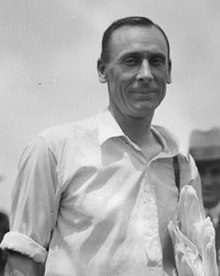Sir Jack Hobbs
 |
||||||||||||||||||||||||||||||||||||||||
| Personal information | ||||||||||||||||||||||||||||||||||||||||
|---|---|---|---|---|---|---|---|---|---|---|---|---|---|---|---|---|---|---|---|---|---|---|---|---|---|---|---|---|---|---|---|---|---|---|---|---|---|---|---|---|
| Full name | John Berry Hobbs | |||||||||||||||||||||||||||||||||||||||
| Born |
16 December 1882 Cambridge, England |
|||||||||||||||||||||||||||||||||||||||
| Died | 21 December 1963 (aged 81) Hove, East Sussex, England |
|||||||||||||||||||||||||||||||||||||||
| Nickname | The Master | |||||||||||||||||||||||||||||||||||||||
| Batting style | Right-handed (RHB) | |||||||||||||||||||||||||||||||||||||||
| Bowling style | Right-arm medium pace (RM) | |||||||||||||||||||||||||||||||||||||||
| Role | Opening batsman | |||||||||||||||||||||||||||||||||||||||
| International information | ||||||||||||||||||||||||||||||||||||||||
| National side | ||||||||||||||||||||||||||||||||||||||||
| Test debut (cap 157) | 1 January 1908 v Australia | |||||||||||||||||||||||||||||||||||||||
| Last Test | 16 August 1930 v Australia | |||||||||||||||||||||||||||||||||||||||
| Domestic team information | ||||||||||||||||||||||||||||||||||||||||
| Years | Team | |||||||||||||||||||||||||||||||||||||||
| 1905–1934 | Surrey | |||||||||||||||||||||||||||||||||||||||
| Career statistics | ||||||||||||||||||||||||||||||||||||||||
|
||||||||||||||||||||||||||||||||||||||||
| Source: CricketArchive, 18 June 2010 | ||||||||||||||||||||||||||||||||||||||||
Sir John Berry "Jack" Hobbs (16 December 1882 – 21 December 1963) was an English professional cricketer who played for Surrey from 1905 to 1934 and for England in 61 Test matches between 1908 and 1930. Known as "The Master", he is regarded by critics as one of the greatest batsmen in the history of cricket. He is the leading run-scorer and century-maker in first-class cricket, with 61,760 runs and 199 centuries. A right-handed batsman and an occasional right-arm medium pace bowler, Hobbs also excelled as a fielder, particularly in the position of cover point.
Born into poverty in 1882, Hobbs wished from an early age to pursue a career in cricket. His early batting was undistinguished, but a sudden improvement in 1901 brought him to the attention of local teams. In 1903 he successfully applied to join Surrey, with the support of England batsman Tom Hayward. His reputation grew and when he qualified to play for Surrey, he scored 88 on his first-class debut and a century in his next game. Over the following seasons, he established himself as a successful county player and in 1908 made his Test debut for England, scoring 83 in his first innings. After some mixed early performances for England, Hobbs' success against South African googly bowlers made his place secure, and by 1911–12, when he scored three centuries in the Test series against Australia, critics judged him the world's best batsman. In county cricket, he developed an attacking, dynamic style of play and was very successful up until 1914. After serving in the Royal Flying Corps during the First World War, he maintained his reputation when cricket resumed in 1919, but his career was threatened by appendicitis, which caused him to miss most of the 1921 season. When he returned, he was a more cautious batsmen and used a safer style of play. Subsequently, he became more consistent and scored prolifically in both Test and domestic cricket until his retirement. In this period, he played some of his most acclaimed innings.
...
Wikipedia
